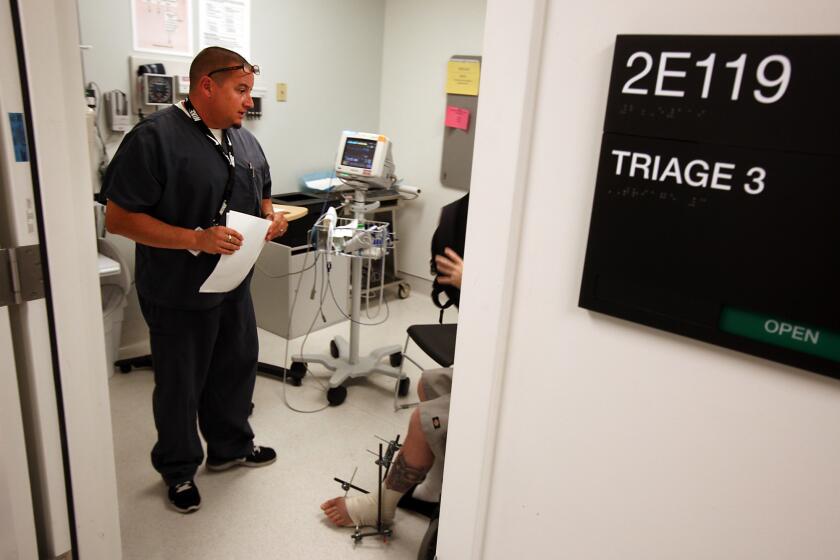Column: California fines Aetna (but not enough) for wrongly denying claims for ER visits

Among the most cynical and savage innovations we’ve seen in health insurer behavior in recent years are policies that refuse members’ claims for emergency room visits later deemed “unnecessary.”
As we’ve reported in the past, these policies are designed almost exclusively to save the insurers money by forcing consumers to jump through bureaucratic hoops to cover bills that could exceed $10,000, or to discourage them from going to the ER at all, even when they’re suffering pains that could signal serious conditions.
Anthem Blue Cross was a pioneer of this obnoxious practice, but other insurers have tried it out. Among them is Aetna, which has just been fined $500,000 by the California Department of Managed Health Care for continuing to second-guess its customers despite repeated warnings — and previous fines — that it was violating state law.
Patients don’t come with a sticker on their forehead saying what the diagnosis is....We as physicians can’t always distinguish necessary from unnecessary [ER] visits.
— Renee Hsia, UC San Francisco
Aetna’s “failure to follow California law for reimbursing emergency room claims is unacceptable,” Acting DMHC Director Mary Watanabe said upon announcing the latest fine on Aug. 25.
The department’s sample of ER claims denied by Aetna in 2019 found that a stunning 93% were wrongly denied.
It’s proper to note that, for Aetna, the $500,000 fine is pocket change. The company, which is now part of CVS Health, generated $63 billion in premiums last year, or about one quarter of the parent company’s $256.8 billion in total revenue.
Before we get more deeply into Aetna’s behavior, let’s look at the general practice of denying ER claims and its ostensible rationale.
Insurers made the case to indulgent regulators in some states, such as Georgia and Indiana, that it made sense to control healthcare costs by steering patients away from expensive ER services and toward doctor offices or urgent-care clinics.
“People who have a cold or use the ER as their primary physician — that’s got to stop,” a spokesperson for Blue Cross Blue Shield of Georgia said in 2017, when that insurer rolled out the policy. “This really is a question of getting healthcare more affordable.”
The process was that after a patient submitted an ER claim, a paper-pusher at insurer headquarters would examine it retrospectively and determine whether the ER visit had been warranted.
The flaw in the process should be obvious: Laypersons haven’t the expertise to determine that chest pains, abdominal pains or headaches are merely transient rather than indicating, say, a coronary, appendicitis or a stroke.
Sometimes doctors themselves can’t tell prior to an examination.
Anthem is the nation’s second-largest health insurer, with thousands of medical professionals on its payroll.
“Patients don’t come with a sticker on their forehead saying what the diagnosis is,” Renee Hsia of the Institute for Health Policy Studies at UC San Francisco, who has studied the difficulty of making snap diagnoses at the ER, told me in 2017. “We as physicians can’t always distinguish necessary from unnecessary visits.”
The Affordable Care Act, which guarantees insurance coverage of emergency services, defines appropriate ER visits as those for eventualities that “a prudent layperson, possessing an average knowledge of medicine and health,” would believe needed immediate treatment to avoid serious jeopardy to the patient’s health or serious impairment of bodily functions or organs.
The rule was aimed at protecting patients, not subjecting them to retroactive second-guessing. The goal was to require insurers to base their claims payments on what an average person would consider an emergency, not on the final diagnosis reached by doctors after examinations and tests at the ER.
Anthem’s rule risked widespread denials of claims filed by patients who couldn’t possibly know what they faced, according to a 2018 study published by JAMA Network Open, which is affiliated with the Journal of the American Medical Assn.
The study found that 1 in 6 ER visits could be denied coverage under the rule, but that up to 40% of the visits considered nonemergencies were probably appropriate ER visits. Those visits presented the same symptoms as are seen in about 90% of ER visits, the study said.
California’s rule is more stringent than the ACA’s. It says that insurers must pay ER claims unless they determine that “the emergency medical services were never performed or that ... the enrollee did not require emergency medical services; and ... reasonably should have known that an emergency did not exist.”
The distinction may look subtle, but the California rule shifts the burden of proof from the patient to the insurer.
As the DMHC explains in its enforcement document, the “prudent layperson” rule allows an insurer to deny payment for an ER visit unless the record shows that the layperson would have known that his or her condition was truly an emergency. The California rule requires payment unless the insurer can show that no emergency service was performed or that the patient should have known that an emergency did not exist.
California law also warns insurers against “engaging in a ‘demonstrable and unjust pattern’ of denying complete and accurate claims.” That means any practice or policy resulting in “repeated delays in the adjudication and correct reimbursement of provider claims.”
An Aetna spokesman told me that the company is “committed to providing our members with appropriate access to emergency room services and to complying with all laws applicable to our business.”
Yet in California, Aetna has been a recidivist scofflaw. California regulators caught the company applying the “prudent layperson” rule instead of the California standard in 2010, and extracted Aetna’s promise to put corrective procedures in place.
In 2015, Aetna got caught again and agreed to pay a $10,000 penalty for one denial and to institute new training for its ER claims staff. Then it got caught again in 2016, this time paying a $125,000 penalty.
In the last few years, Anthem Blue Cross has made a strong bid for the award for the most heartless and senseless coverage policy in the health insurance business.
Nevertheless, the DMHC says, complaints continued to surface in 2017 and 2018. Finally, the agency conducted a survey in 2019, and discovered that despite all the penalties and promises, Aetna had reverted back to the “prudent layperson” rule, which violated state law.
The result of Aetna’s procedures, DMHC says, was to raise obstacles to customers seeking payment. The agency found that since 2017, Aetna customers faced “repeated delays in the correct reimbursement of emergency claims.” They were forced to file grievances with Aetna and eventually to file complaints with the department. In other words, Aetna was engaging in an “unjust pattern” of denying claims, which is itself illegal.
Unfortunately, what this pattern demonstrates is Aetna’s willingness to flout state law on the knowledge that the worst it can face is a wrist-slap — a few hundred thousand bucks in fines out of revenues of tens of billions. Why not keep denying claims if that’s all it will cost?
There is a reason to knock this practice off, however: The evidence shows that it doesn’t save any money. After the practice was in place for several years, Anthem discovered that it had reversed on appeal the vast majority of claims denials.
Over time, Anthem found itself broadening the exemptions to its rule — that is, expanding the cases in which ER claims would be paid automatically, no questions asked, because the incessant appeals were creating an administrative burden for itself.
But the message didn’t seem to percolate through to Aetna. The company says it has “taken a number of steps to help ensure that we handle emergency room claims consistent with California’s standard.”
But it has said that before. What guarantees that this time will be any different?
More to Read
Inside the business of entertainment
The Wide Shot brings you news, analysis and insights on everything from streaming wars to production — and what it all means for the future.
You may occasionally receive promotional content from the Los Angeles Times.













